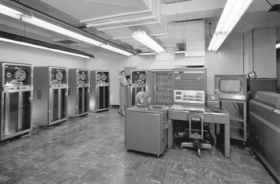History

Several manufacturers and their successors produced mainframe computers from the late 1950s until the early 21st Century, with gradually decreasing numbers and a gradual transition to simulation on Intel chips rather than proprietary hardware. The US group of manufacturers was first known as "IBM and the Seven Dwarfs"::p.83 usually Burroughs, UNIVAC, NCR, Control Data, Honeywell, General Electric, and RCA, although some lists varied. Later, with the departure of General Electric and RCA, it was referred to as IBM and the BUNCH. IBM's dominance grew out of their 700/7000 series and, later, the development of the 360 series mainframes. The latter architecture has continued to evolve into their current zSeries mainframes which, along with the then Burroughs and Sperry (now Unisys) MCP-based and OS1100 mainframes, are among the few mainframe architectures still extant that can trace their roots to this early period. While IBM's zSeries can still run 24-bit System/360 code, the 64-bit zSeries and System z9 CMOS servers have nothing physically in common with the older systems. Notable manufacturers outside the US were Siemens and Telefunken in Germany, ICL in the United Kingdom, Olivetti in Italy, and Fujitsu, Hitachi, Oki, and NEC in Japan. The Soviet Union and Warsaw Pact countries manufactured close copiescitation needed of IBM mainframes during the Cold War; the BESM series and Strela are examples of an independently designed Soviet computer.
Shrinking demand and tough competition started a shakeout in the market in the early 1970s—RCA sold out to UNIVAC and GE sold its business to Honeywell; between 1986 and 1990 Honeywell was bought out by Bull; UNIVAC became a division of Sperry, which later merged with Burroughs to form Unisys Corporation in 1986.
In 1984 estimated sales of desktop computers ($11.6 billion) exceeded mainframe computers ($11.4 billion) for the first time. IBM received the vast majority of mainframe revenue. During the 1980s, minicomputer-based systems grew more sophisticated and were able to displace the lower-end of the mainframes. These computers, sometimes called departmental computers were typified by the DEC VAX.
In 1991, AT&T Corporation briefly owned NCR. During the same period, companies found that servers based on microcomputer designs could be deployed at a fraction of the acquisition price and offer local users much greater control over their own systems given the IT policies and practices at that time. Terminals used for interacting with mainframe systems were gradually replaced by personal computers. Consequently, demand plummeted and new mainframe installations were restricted mainly to financial services and government. In the early 1990s, there was a rough consensus among industry analysts that the mainframe was a dying market as mainframe platforms were increasingly replaced by personal computer networks. InfoWorld's Stewart Alsop infamously predicted that the last mainframe would be unplugged in 1996; in 1993, he cited Cheryl Currid, a computer industry analyst as saying that the last mainframe "will stop working on December 31, 1999", a reference to the anticipated Year 2000 problem (Y2K).
That trend started to turn around in the late 1990s as corporations found new uses for their existing mainframes and as the price of data networking collapsed in most parts of the world, encouraging trends toward more centralized computing. The growth of e-business also dramatically increased the number of back-end transactions processed by mainframe software as well as the size and throughput of databases. Batch processing, such as billing, became even more important (and larger) with the growth of e-business, and mainframes are particularly adept at large-scale batch computing. Another factor currently increasing mainframe use is the development of the Linux operating system, which arrived on IBM mainframe systems in 1999 and is typically run in scores or up to c. 8,000 virtual machines on a single mainframe. Linux allows users to take advantage of open source software combined with mainframe hardware RAS. Rapid expansion and development in emerging markets, particularly People's Republic of China, is also spurring major mainframe investments to solve exceptionally difficult computing problems, e.g. providing unified, extremely high volume online transaction processing databases for 1 billion consumers across multiple industries (banking, insurance, credit reporting, government services, etc.) In late 2000, IBM introduced 64-bit z/Architecture, acquired numerous software companies such as Cognos and introduced those software products to the mainframe. IBM's quarterly and annual reports in the 2000s usually reported increasing mainframe revenues and capacity shipments. However, IBM's mainframe hardware business has not been immune to the recent overall downturn in the server hardware market or to model cycle effects. For example, in the 4th quarter of 2009, IBM's System z hardware revenues decreased by 27% year over year. But MIPS (millions of instructions per second) shipments increased 4% per year over the past two years. Alsop had himself photographed in 2000, symbolically eating his own words ("death of the mainframe").
In 2012, NASA powered down its last mainframe, an IBM System z9. However, IBM's successor to the z9, the z10, led a New York Times reporter to state four years earlier that "mainframe technology—hardware, software and services—remains a large and lucrative business for I.B.M., and mainframes are still the back-office engines behind the world's financial markets and much of global commerce". As of 2010update, while mainframe technology represented less than 3% of IBM's revenues, it "continued to play an outsized role in Big Blue's results".
In 2015, IBM launched the IBM z13, in June 2017 the IBM z14 and in September 2019 IBM launched the latest version of the product, the IBM z15.
Comments
Post a Comment